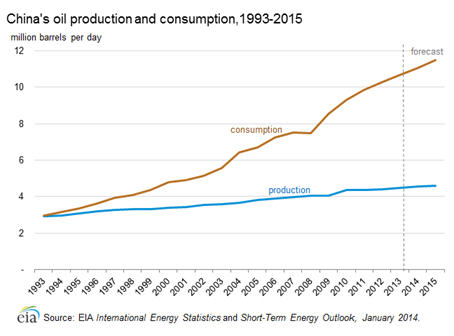China: The world's biggest energy consumer and producer |
- China: The world's biggest energy consumer and producer
- Oil sands emissions likely underestimated, study finds
- Dominion to sell diamonds online from Diavik and Ekati
- Trouble with Indonesian government leads to Newmont downgrade
- Avino Silver and Gold Mines up 5 pct on monthly production increase
- Mining deals for about $10bn coming soon to a market near you—E&Y
| China: The world's biggest energy consumer and producer Posted: 04 Feb 2014 02:35 PM PST It may not come as much of a surprise but China is the biggest consumer and producer of energy in the world. It has been since 2010. Just to put it into perspective, here are some facts from the US Energy Information Administration (EIA):
The EIA recently released its forecasts for the Chinese oil sector and their chart shows an ever-widening rift between China's consumption and production of the fuel source. The EIA predicts that China's oil consumption will reach nearly 12 million barrels per day by 2015, up from close to 11 million today. The country produced an estimated 4.5 million barrels per day of total oil liquids in 2013 and the EIA expects this figure to rise to about 4.6 million barrels per day by the end of 2014. But that won't be nearly enough: In 2013 China consumed an estimated 10.7 million barrels of oil per day and is predicted to consumer about 11.1 million in 2014. Oil, gas and other sources are expected to play an increasingly larger role in China's energy mix as the country strives to reduce its dependence on coal – although whether or not the People's Republic is serious about this goal is a matter of debate. Along with its other first-place rankings, China also holds the title of the world's biggest energy-related CO2 emitter. |
| Oil sands emissions likely underestimated, study finds Posted: 04 Feb 2014 12:41 PM PST  Oil sands development in Alberta Pollution from Alberta's oil sands: The subject has drawn commentary from everyone and their mothers – and most recently rock star Neil Young. But when members of the scientific community weigh in, more people pay attention. A recent study from the University of Toronto has certainly caught the media's eye. Researchers Abha Parajulee and Frank Wania say that emissions estimates of potentially toxic chemicals – polycyclic aromatic hydrocarbons (PAHs) – used to approve oil sands development projects are likely too low. In other words, we may have underestimated the impact of oil sands mining on our health and environment. The study incorporates a wide range of emissions data into multimedia modelling. Taking a comprehensive look at emissions, the study includes not just direct air pollution during the extraction process but also indirect emissions such as evaporation and seepage from tailings ponds, emissions from vehicle traffic, wind erosion and transportation of exposed bitumen. "Our results highlight the need for improved accounting of PAH emissions from oil sands operations, especially in light of continued expansion of these oeprations," Parajulee and Wania wrote. The study shows that environmental assessment procedures base their reports on emissions estimates that are likely too low. "This finding implies that environmental concentrations in exposure-relevant media, such as air, water, and food, estimated using those emissions may also be too low," researchers wrote. "The potential therefore exists that estimation of future risk to humans and wildlife because of surface mining activity in the Athabasca oil sands region has been underestimated." The researcher's modeling calculated emission levels that are more in line with actual PAH levels measured in samples taken from the Athabasca oil sands region. In fact, the emissions to air levels required to explain the measured concentrations of pollutants would have to be "two to three orders-of-magnitude larger than those reported," the study reads. Parajulee and Wania's modeling brings Canada's emissions estimates more within range of other major oil-producing nations such as the US and Norway. |
| Dominion to sell diamonds online from Diavik and Ekati Posted: 04 Feb 2014 10:36 AM PST
Delivering an update for both operations Monday, the company said this year it will produce about 7% fewer carats from Diavik mine, in Canada's Northwest Territories, resulting in cost savings of roughly 16% as underground development at the site wound down. Based on Diavik's current reserves, the updated mine plan could support mining until 2023, after which Dominion would spend about Cdn$188 million in reclamation costs, a task expected to be complete by 2030. At its 80%-owned Ekati mine, Dominion expects to produce 1.22 million carats from the Fox, Misery, Pigeon and Lynx open pits and the Koala and Koala North underground operations. The plan will give this mine an extra six years of productive life. While the firm did not mention its plans to launch a business-to-business platform, reports indicate the move would help Dominion gain some understanding into the polished diamond markets, which it drew away from, after it sold its Harry Winston jewellery brand to Swatch Group AG last year. Image by Payless Images |
| Trouble with Indonesian government leads to Newmont downgrade Posted: 04 Feb 2014 09:40 AM PST Newmont Mining (NYSE:NEM) made it clear last week that its problems with the Indonesian government were pressing: CEO Gary Goldberg said the company might curtail operations if the issue over a new export tax isn't resolved over the next few months, Reuters reported. Now analysts at JP Morgan have downgraded the world's second biggest gold miner from an 'overweight' to a 'neutral' rating, citing the Indonesian impasse as a reason. "Newmont reported a strong Q4 result but this was overshadowed by the demands of the Indonesian host government on Newmont's Batu Hijau project for more domestic value add via the local smelting of the concentrate," the research note read, as reported by Barron's Blog. Indonesia recently introduced highly controversial restrictions on ore shipments in order to the boost the domestic processing industry. It also hiked the export tax on metal concentrates; for copper, this will rise the tax to a maximum of 60% of a shipment's value by the second half of 2016, according to Reuters. Newmont claims that it is exempt from these taxes based on its initial 'Contract of Work' with the Indonesian government and argues that it is not economically viable for the company to build its own smelter, though it has negotiated and signed conditional concentrate supply agreements with two Indonesian companies that plan on building their own copper smelters. Analysts say that the Indonesian government has created a "very uncertain" investment climate, but that it's not the only one: The researchers point to the Dominican Republic and Ecuador as examples of governments becoming increasingly concerned about how much they're getting from the resource extraction industry. Meanwhile, TD Securities cut its price target for Newmont from $28 to $24, according to Ticker Report. Analysts at Sterne Agee have cut their price target for the company to $30, but have a 'buy' rating on the stock. Analysts at RBC already downgraded the miner last week after the company released production targets for 2014. Newmont's share price was unchanged on Tuesday, trading at $21.02. Over the past five days the miner has dropped around 16%. The share price has lost more than half its value over the past 12 months. |
| Avino Silver and Gold Mines up 5 pct on monthly production increase Posted: 04 Feb 2014 08:48 AM PST  The Avino Mine property includes the Avino Mine (open-pit/underground past producer) and San Gonzalo Mine. The Avino mine property is situated around the towns of Panucho de Coronado and San Jose de Avino (Durango, Mexico) and surrounding the formerly producing Avino mine, 80 km north east of Durango. Map from Company/PropertyMine. Avino Silver and Gold Mines (CVE:ASM) announced a 27% production increase in January 2014 over December to 105,551 ounces of silver equivalent. The company was up 5.13% to $2.05 a share as of 11 a.m. EST. Avino's CEO attributed the production jump to better grades and more processing equipment coming on line. "In 2014 we expect a significant increase in our overall output as we continue to encounter improved grades and experience better recoveries as we move deeper into the San Gonzalo mine; as anticipated," said David Wolfin, President, CEO & Director, Avino Silver & Gold Mines Ltd in a news release. "We will also be processing material through both circuits 1 and 2 for the full year with the expectation of circuit 3 coming online in the 4th quarter to process material from the Avino Mine." The Mexico-based miner said silver and gold feed grades for January increased significantly over those of December by 26% and 18% respectively. The miner is up a full 71% since the year started. Avino Silver and Gold Mines also also holds precious metals properties in British Columbia and Yukon Territory. |
| Mining deals for about $10bn coming soon to a market near you—E&Y Posted: 04 Feb 2014 07:04 AM PST More upbeat news for the mining sector. After a tough 2013 that saw the lowest number of merger and acquisition (M&A) activity since 2006, experts are seeing a change of gears, with financial investors and equity-backed alternative capital providers beginning to be particularly active in the M&A market. According to consultancy firm EY's latest report, anticipated longer term commodity price recovery and the ability to leverage management ability will be pushing M&A deals up in the first half of 2014. The analysts estimate there is a US$10 billion deal capacity across the sector, which will likely materialize in some big deals later this year and in 2015. EY's Global Mining & Metals Transactions Leader, Lee Downham, said in a statement that mining investors will continue to focus mainly on low risk jurisdictions, as a way to leverage under-performing assets, using technical, operational and financial influence to generate better returns. Juniors to wait a little longer  While the best time to undertake M&A is at the bottom of the market, this has not historically proven to be the case. This graph shows little correlation between commodity price peaks (and possibly the timing of decisions) and when deals are completed. The analysts are also expecting to see a strong appetite from debt providers, with increased competition among banks likely to improve access to leveraged loans for quality mid-tier mining companies and developers. However, the report notes that given the strict criteria applied by investors, it is still premature to think these funds will be available to support the mining industry's needs as a whole. "Risk capital for juniors is unlikely to be available on any large scale in 2014. While the best development projects will continue to attract funding from the increasing pool of private capital, it may take a longer period of sustained commodity prices and cost control discipline across the sector before we see strong investor confidence and IPO markets open for juniors," Downham said. "Many juniors have effectively suspended exploration and development activities to conserve cash for survival. Without new capital and new investment, the mining sector may well be sowing the seeds for the next boom as supply falls short of demand," he added. Read the full report here. Image Everett Collection/Shutterstock.com |
| You are subscribed to email updates from MINING.com To stop receiving these emails, you may unsubscribe now. | Email delivery powered by Google |
| Google Inc., 20 West Kinzie, Chicago IL USA 60610 | |




0 Comment for "China: The world's biggest energy consumer and producer"